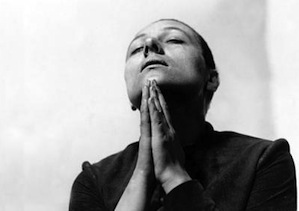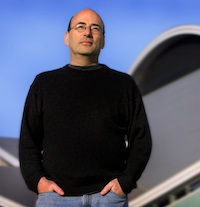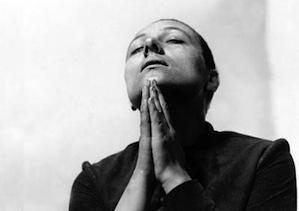
People often say that seeing a movie changed their lives. In Richard Einhorn’s case, it’s true. The composer’s first viewing of Carl Dreyer’s 1928 silent film, The Passion of Joan of Arc, moved him to write a new work that would become inextricably linked with Dreyer’s masterpiece. Voices of Light, which Einhorn completed in 1994, is scored for four vocal soloists, chorus, orchestra, and electronics; it made its world premiere in Northampton, Massachusetts, in 1994, and was subsequently performed at the Brooklyn Academy of Music (BAM). Since then, it has been performed around the world; Bay Area audiences first heard it in 1996 on the San Francisco Symphony’s Great Performers series. The 90-minute oratorio is occasionally performed on its own (and was recorded on Sony Classical), yet it most often accompanies showings of Dreyer’s film. On March 31 at Zellerbach Hall, Cal Performances presents Voices of Light — and the Dreyer film that inspired it — in a special multimedia performance conducted by Marin Alsop and featuring the Baltimore Symphony and the UC Choral Ensembles. Einhorn spoke to SFCV by phone from his studio in New York City.
Featured Video
The Passion of Joan of Arc
Voices of Light has had quite a history.
Yes. It was first performed in Northampton, in the middle of a blizzard. Word of mouth spread immediately. BAM was the first major performance, and I was approached by Sony Classical to record it. Right after that, there were two U.S. tours, and a whole bunch of other performances, as well. It’s really been very well received, and Marin Alsop just did three performances with the Baltimore Symphony in Bethesda. They were just amazing performances.
How did you get involved in the project? What drew you to the film, and the idea of composing the score?
I had wanted to do a piece about religion for a long time — not a religious piece, but a piece which took some sort of religious subject matter as its topic. I wanted it to be a large piece. A friend suggested Joan of Arc as a subject, and I thought, no: the stories aren’t true, and she’s not that interesting. Then, I was researching an entirely different project, looking at old avant-garde films in New York’s Museum of Modern Art film archives. I saw the [Dreyer] film, and I just fell in love. I was devastated by it. I thought it was one of the greatest movies I’d ever seen. I basically dropped everything else and started to plan this project.
How long did you work on it?

I spent about five years trying to get it off the ground, and then finally somebody said “yes” in Northampton. I jumped at the chance, and wrote it very quickly. It only took about five months to write. It turned out that Joan was the perfect subject for me. There’s no question of her religious belief, or her importance as a Catholic saint. But she doesn’t fit any mold. She’s an uncomfortable saint for the Catholic hierarchy, even today — after all, she’s the only saint who was excommunicated before she was sanctified!
Have you been surprised by the work’s success?
It’s been amazing. My idea of success was a second performance. Every composer I know, myself included, is grateful for one performance. We dream of second performances. This piece has had over 200. I’ve gone to about half of them, and every single one that I’ve seen has been in its own way different, so I learn something new. I certainly believed in the project, and I believed that it would move people, but the kind of success it’s had has been amazing.
Everyone thinks that contemporary music is difficult, or something that people aren’t interested in. The truth of the matter is that, at least with this piece, you can reach people if it’s compelling. The film is so extraordinary that it helps to get people focused on the entire project. And that was the whole point of Voices of Light — once I saw this amazing film, I wanted everybody to see it. The thing I’m most proud of is that probably more people have seen the film in performances of Voices of Light than saw it in the entire history of the film before.
The score draws on Latin, Italian, and Medieval French texts. Talk about how you selected the texts and incorporated them in the score.
I was devastated by Dreyer’s film. I thought it was one of the greatest movies I’d ever seen.
The first thing that everybody knows about Joan of Arc is that she heard voices. So I decided the piece had to have voices. The question was, what texts? I decided to use texts by medieval female mystics from Joan’s time or earlier. I went to this amazing bookstore that specialized in Catholic scholarly texts, and asked the clerk if they had any by female mystics. It turned out Hildegard von Bingen’s poetry had just been published, writings outside of her journals. I bought about six or seven of these books and started to assemble the texts based on themes from Joan’s life — themes of fire, of cross-dressing, torture, war, etc. I contacted other scholars, and they gave me more texts. My first criterion was beauty. I wanted beautiful, beautiful texts. And I started putting them together so they would comment, in a sort of oblique way, on the film. That’s basically how it happened. I watched the film many, many times and broke it down into 15 movements, assembled the texts, and wrote the music. It’s not really a film score, at least not the way I see it. From my standpoint, the idea was to create something that would run parallel to The Passion of Joan. I thought that was the best way to honor the film.
Did you learn more about Joan from the film?
Marin Alsop is awesome. She’s a force of nature.
Yes. I wanted to go deep into the Joan of Arc story, as Dreyer did. He became obsessed with Joan. There are all sorts of subtle and amazing things in the film that only someone who knew Joan’s story would have found. And, like a lot of other people who study her, I too got obsessed with Joan.
After Voices premiered, it seemed that it did generate interest in Joan — and also in Hildegard. For some people, the piece may have been the first introduction to Hildegard’s writings and her music.
That makes my day. In fact, I didn’t know Hildegard’s music when I began writing this piece. I just knew her as a poet, and I thought, this is a woman whose writing moves me as much as Dante. It was astonishing. Later, I think Sequentia came out with a recording. That was the first recording of her music I heard. And then of course Anonymous Four, who did the Voices of Light project, did a Hildegard record just after that. After 900 years, all this magnificent music reappeared. Of course, now we know a great deal about Hildegard. She was a genius. That was one of the cool things about this project. Everywhere I turned, all of these extraordinary things kept coming up.
Marin Alsop has been a strong advocate for Voices of Light, conducting it at the Cabrillo Festival here in the Bay Area, and elsewhere. What does she bring to the piece?
Marin is awesome. She’s a force of nature. The first time she did it was at Cabrillo, and it was a wonderful performance. She’s done it with the Colorado Symphony, and London Symphony, [plus] three performances with Baltimore. What she brings to it is an unbelievable level of musicianship. When you write a piece, you know it very well, and you think you know everything about it. Even so, when you hear it in the hands of a good conductor, you learn a lot. When you hear it in the hands of a great musician like Marin, you think I did that? You go into an altered state, and you simply can’t believe that someone can find these things in the music that you wrote and bring them out.

